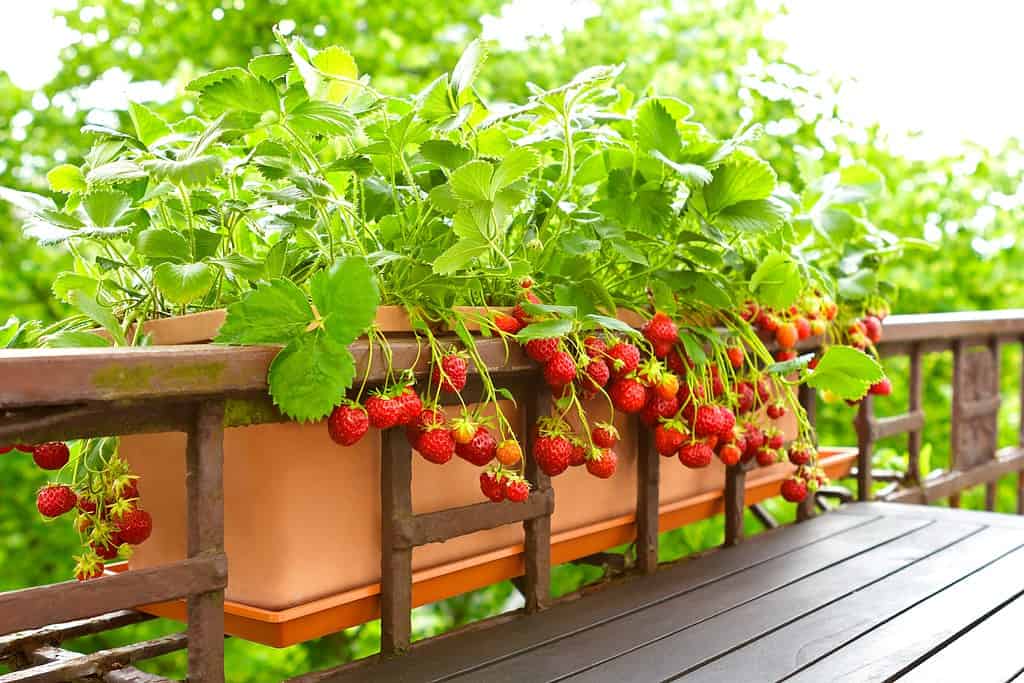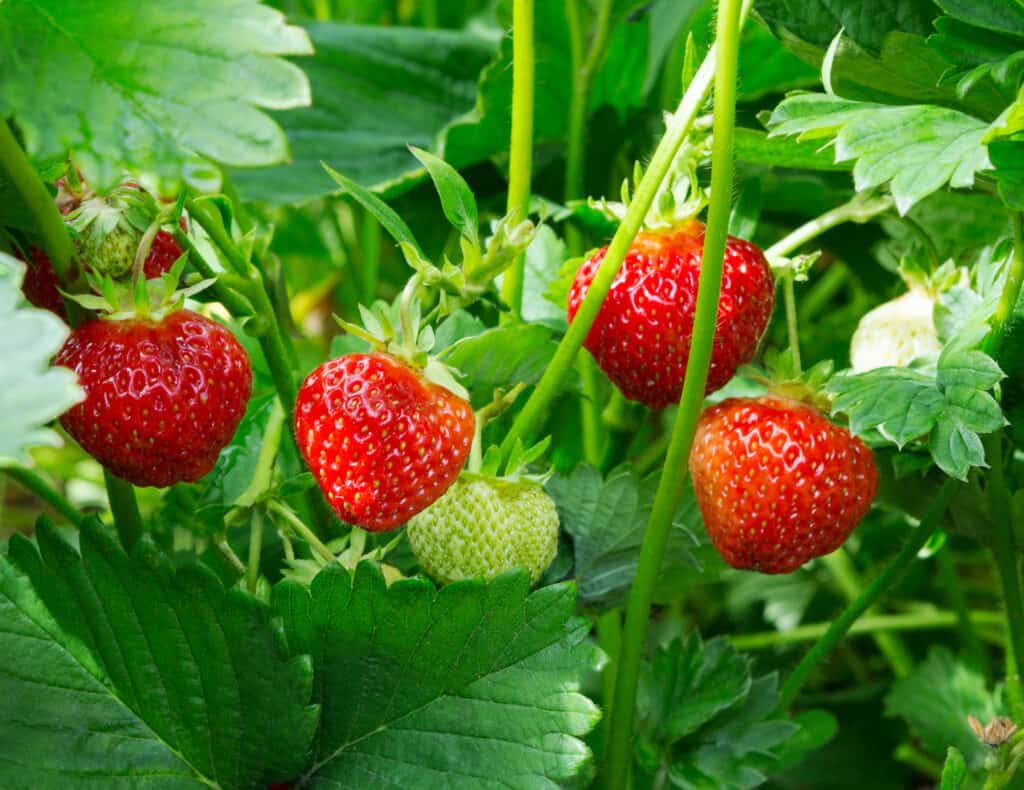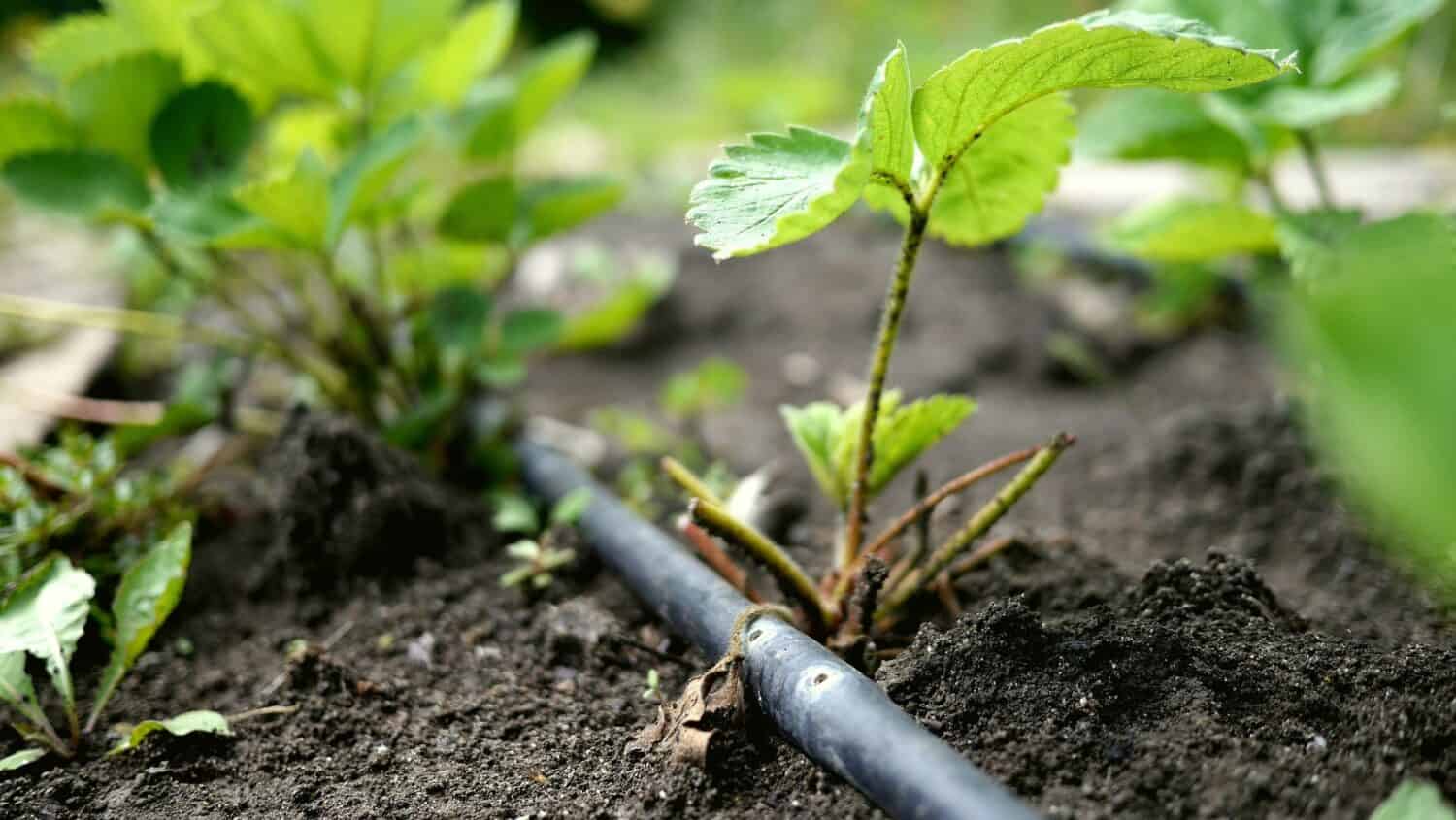Do you want the sweet, delicious taste of strawberries without the ever-rising store prices? You’re in luck! Growing strawberries in Tennessee is a common practice and is easy to get right with a little bit of patience.
In this article, we’ll talk about a few of the best strawberry varieties to grow in the state and give some general tips to help you keep your plants producing plump, juicy fruit.
Best Strawberries for Tennessee Gardens
Strawberries are perennials, which means they return year after year to bear their delicious fruits. Choosing the right cultivar for you and your garden space means that you’ll have a bounty of your favorite fruit, just how you like it, for years to come.
Garden Cultivars
The strawberries you’re probably familiar with already, the ones from the store, are garden cultivars. Farmers and gardeners have developed these cultivars over generations, selecting for the biggest and best fruits, the fastest growth, and the strongest resistance to disease. They have been developed to grow in a wide range of conditions, but some grow exceptionally well in Tennessee.

While many people grow strawberries in garden beds, many varieties perform well in containers too. If you’re tight on space or don’t have a yard, consider a porch garden.
©Agenturfotografin/Shutterstock.com
Honeoye, for example, grows exceptionally well in the cooler, higher elevations of East Tennessee. It begins blooming in the late spring and produces an early to mid-summer harvest. Gardeners sometimes grow this species as an annual, as the high summer humidity can encourage fungal problems. However, it makes a great perennial strawberry as well!
Earliglow is another great strawberry for Tennessee gardens. It produces fairly large, flavorful fruits early in the summer and is a great choice for growing in matted rows. It is also very resistant to verticillium wilt and red stele, both of which can affect strawberry plants during wet and humid summers.
Many cultivars will be ready for harvest early in the summer, between May and June. These are aptly called june-bearing, or short-day strawberries. Others, the everbearing cultivars, will produce fruit repeatedly until the first frost. Expect flowers and fruit from May to mid-October as long as temperatures remain below 86 degrees. While summer heat waves may slow them down, ever-bearers will almost always produce a second flush in the fall.
Native Strawberries
Though their fruits are often much smaller, you may want to consider species like the wild strawberry (Fragaria virginiana) or the alpine strawberry (Fragaria vesca). These native strawberries are already adapted to the climate throughout most of Tennessee. These native species are easy to grow, are less fussy overall, and tend to be more resilient in the face of pests and disease. Cultivators have used F. virginiana to develop hundreds of hybrid cultivars for these exact reasons!

Native strawberries tend to be much smaller than store-bought, but are quite resilient and produce an abundance of fruit!
©Andriy Blokhin/Shutterstock.com
Gardeners can reap a host of rewards from these strawberries for less work. Like garden ever bearers, both of these species will produce flowers and fruit as long as temperatures are suitable. In ideal conditions, gardeners may see up to three harvests in the same year. The spring flowers attract native bees, moths, and other pollinating insects, and the subsequent fruits feed local birds, small mammals, and, of course, you!
Tips for Growing Strawberries in Tennessee
Once you’ve chosen your favorite cultivar, you’re well on your way to a delicious bounty of strawberries. The growing tips below will get you started and help you keep your strawberry plants in tip-top shape!
1. Have Patience
Growing good, ripe strawberries takes time — especially if you’re just starting. While you’re likely to have your first harvest within a few months, know that new strawberry plants can take up to a year before they start producing. Have a little patience at the onset and your plants will reward your dedicated care down the line.
While anticipation of a delicious crop can be almost unbearable, resist the urge to harvest early! Your strawberries won’t ripen on the counter. Check on them regularly as harvest time nears, but don’t pick them until they’re just how you like them.

Be sure you pick your strawberries at the ripeness you enjoy most — they won’t ripen on the counter!
©iStock.com/romiri
2. Plant Early
Regardless of the cultivar you choose, the best time to plant new strawberries in Tennessee is in the spring. Planting early gives your strawberries plenty of time to establish strong roots and foliage before the heat of summer arrives. Aim for February or March once the ground is workable, but know your local frost dates! Even though strawberries are well-suited for our climate, an unsuspected frost can injure new plants once they break their dormancy.
Your timing may change depending on where in Tennessee you live. In the higher elevations of East Tennessee, your ground may not be workable until late March or April and your plants may need frost protection until May!
4. Water Well
Your strawberries will need plenty of water to produce juicy berries! On average, aim to give them an inch or inch-and-a-quarter of water per week. How much and how often you need water will depend on the weather and your garden’s soil structure. Sandier, gravelly soil that drains quickly won’t retain water for very long, meaning you’ll have to water more frequently. On the other hand, soils containing more clay and organic matter tend to have excellent water retention.
Make sure you allow your garden bed to dry out slightly in between watering, and always avoid puddling. Waterlogged soil prevents oxygen from reaching plant roots, weakening your strawberries and leaving them especially susceptible to root rot, red stele, and verticillium wilt.
5. Water Low
When watering your strawberries, try to avoid wetting their leaves. Some fungal infections like leaf spots and leaf scorch spread easily with splashing water and overhead irrigation. While you can’t always avoid wet leaves, watering your strawberries gently at the soil level can help mitigate the spread of foliar diseases.
When watering at soil level, be sure to water slowly. Applying too much water all at once prevents it from penetrating deep into the soil, causing runoff and erosion. Running a soaker hose through your garden bed can be a great choice when working with low-growing plants like strawberries.

Soaker hoses are great for growing strawberries in Tennessee, where wet leaves can quickly turn to fungal infections.
©Nadeene/Shutterstock.com
3. Let Them Breathe
When laying out your garden, give your plants plenty of space. Strawberries need good air flow to keep leaves and fruit from molding in humid conditions. If you have limited space, consider planting a compact variety and trimming back runners to keep growth fairly tight. Strawberries can spread very quickly, so make sure to keep an eye on your plants’ spacing.
6. Apply Mulch
Applying a layer of organic mulch is always a great choice when adding new plants to the garden. Mulch regulates soil temperature, keeping your plants cooler in the summer and warmer in the winter. It also helps lock in moisture, reducing watering costs and ensuring your plants have access to moisture when they need it most.
Organic mulches like straw and wood chips have benefits over inorganic mulches like rubber and plastic. As soil microbes break down the organic matter over time, they contribute to the overall texture and nutrient profile of your garden’s soil!

Applying a layer of mulch to the garden space can help retain water and regulate soil temperature. It also protects the soil microbes that are necessary for a healthy garden!
©OzCameraman/Shutterstock.com
7. Create a Polyculture
To help your garden, consider planting a polyculture. Rather than growing your strawberries in neat rows or large single-species groups, break up the space with companion plants. This practice makes it harder for pests to target your plants and helps develop a healthy and productive garden for the long haul.
Strawberries have many plant allies. Yarrow and dill attract plenty of pollinators like bees and butterflies. In addition to being delicious kitchen herbs, they also attract insects that prey on common strawberry pests like aphids and thrips! Clovers help cover soil, keeping it cool and preventing competitive weeds from sprouting. They even fix nitrogen for your strawberries! As clovers die, soil microbes break down their root nodules and release the built-up nitrogen into the soil. The dead aerial growth also mulches the soil in between seasons!

While some people consider it a weed, white clover is a great companion plant for strawberries. It covers the soil, breaks up plantings, and helps fix nitrogen over the seasons!
©Nocciola/Shutterstock.com
While many plants can help your strawberries thrive, some can harm them inadvertently. Fruits like tomatoes and peppers can carry diseases that spread easily to strawberries, even if they aren’t actively growing together. These diseases can remain in the soil for multiple seasons, so plant them in different beds altogether. Brassicas like Brussels sprouts, broccoli, and cabbage can easily outcompete a strawberry plant, starving it for nutrients. Be careful with your pairings and you will be rewarded with happy plants!
Thank you for reading! Have some feedback for us? Contact the AZ Animals editorial team.








